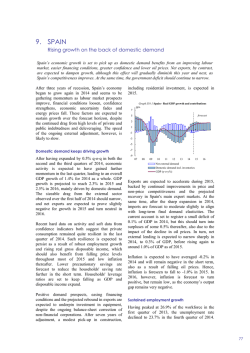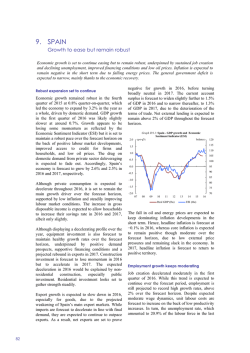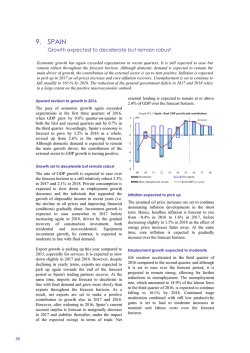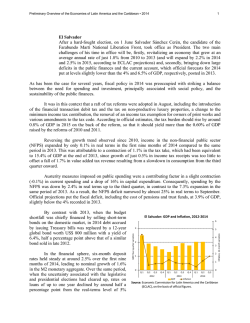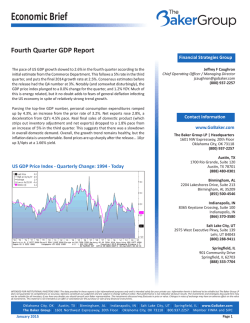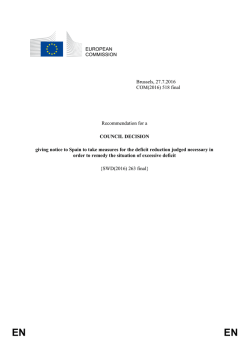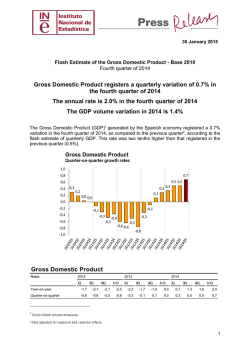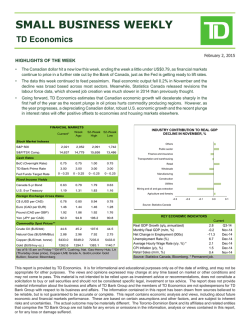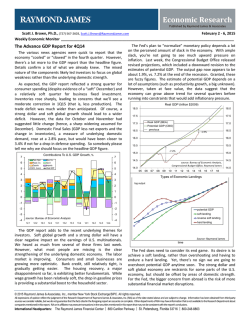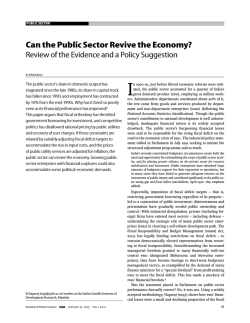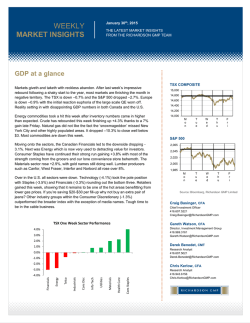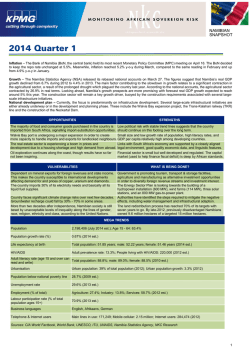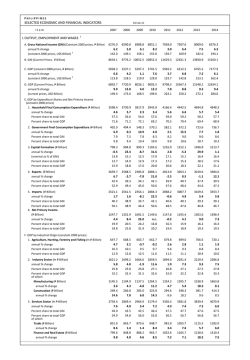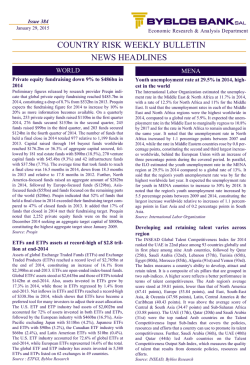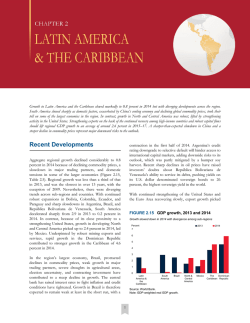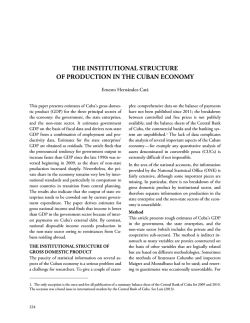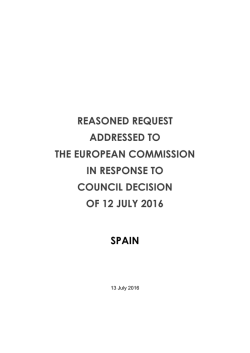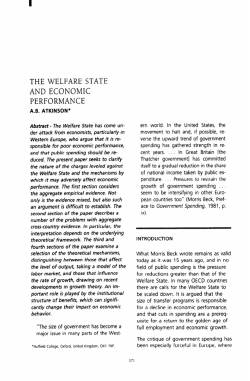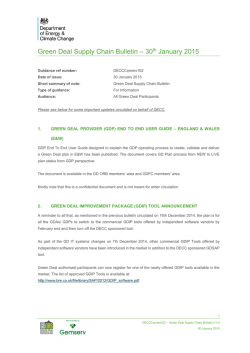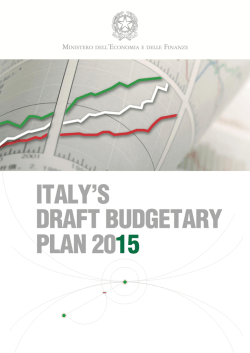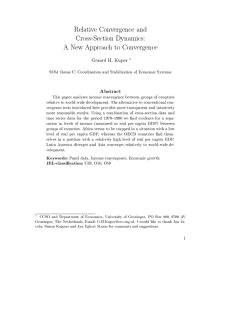
european economic forecast autumn 2014
9. SPAIN GDP and employment growth expected to firm After a temporary slowdown in the second half of 2014, GDP growth is projected to increase in 2015 and 2016, supported in particular by rising employment and easier financing conditions. With domestic demand becoming the main driver of growth, the external surplus is expected to narrow significantly in 2014 relative to 2013 and then to expand slightly in 2015 and 2016. Unit labour cost growth is expected to turn moderately positive, still allowing a further recovery in international competitiveness. Unemployment is expected to continue declining. Spain’s general government deficit is set to narrow in 2014 and 2015. The economic recovery in Spain gained steam over the first half of 2014. Although a modest deceleration is expected for the second half of the year, the recovery is foreseen to regain momentum thereafter amidst improved confidence, a loosening of financing conditions and better labour market prospects. The correction of the external imbalance, however, is likely to slow down and high private and public debt levels imply that deleveraging pressures will continue to weigh on growth. Domestic demand drives growth GDP expanded by 0.6% q-o-q in the second quarter of 2014, after 0.4% in the first quarter. Economic activity is expected to decelerate somewhat during the second half of the year, leading to an average GDP growth rate of 1.2% for 2014 as a whole. Growth is set to come mainly from domestic demand but the external sector should turn neutral, after having been a drag in the first two quarters. Net exports are seen contributing only slightly to growth in 2015 and 2016. The GDP growth rate is projected at 1.7 % in 2015 and 2.2 % in 2016, under a no-policychange assumption. equipment, despite ongoing balance-sheet correction by NFCs. The adjustment in construction appears to be close to its inflection point and some modest pick-up is expected, in particular for residential investment. Following a sharp deceleration in the second half of 2013 and the first half of 2014, exports are set to gain momentum, backed by on-going improvements in price and non-price competitiveness and some recovery in Spain's main export markets. At the same time, imports are forecast to accelerate as final demand grows and as a result of the high import content of equipment investment and Spain's exports. The current account surplus is thus forecast to shrink to 0.5% of GDP in 2014 and to improve slightly thereafter. Net external lending is expected to fall in 2014 to 1.0% of GDP, before rising to 1.5% of GDP by 2016. Graph II.9.1: Spain - Contributions to growth 7 pps. 5 forecast 3 1 -1 Activity and confidence indicators suggest that private consumption is set to decelerate in the second half of 2014. It is however forecast to accelerate progressively thereafter, backed by positive employment growth and growing real gross disposable income, the latter also helped by very low or even negative inflation in the very short term. The household's saving rate, by contrast, is projected to decline due to lower precautionary savings and households' leverage ratios are set to fall further as GDP and disposable income expand. Overall positive demand prospects, easing financing conditions and the projected rebound in exports are expected to underpin investment in 74 -3 -5 -7 -9 06 07 08 09 10 11 12 13 14 15 16 Net exports Domestic demand incl. inventories GDP (y-o-y%) Inflation is projected to remain negative in the near term, with average inflation over 2014 of -0.1%. In 2015 and 2016 inflation is expected to turn positive again but to remain very moderate as the output gap will still be negative and energy prices are projected to fall. Member States, Spain Employment on the rise Having peaked at 26.9% in the first quarter of 2013, the unemployment rate has since declined to 24.5% in the second quarter of 2014. Employment creation accelerated in the first half of 2014, while the labour force continued to contract. These positive trends in employment are expected to intensify over the forecast horizon, helped by continued wage moderation and only modest increases in nominal unit labour costs. With the labour force contraction expected to fade progressively, unemployment is forecast to fall to 22.2% in 2016. Downside risks to the growth forecast are not negligible. They are mainly related to the external sector, should in particular the recovery in the euro area be slower than expected. as a whole is expected to narrow to around 5.6% of GDP, down from 6.3% of GDP in 2013, net of bank recapitalisations in both years. In 2015, an improvement in the economic outlook and ongoing savings resulting from previously enacted reforms are expected to more than offset the announced tax cuts and some relaxation of the public sector's hiring policy. Taking the 2015 budget into account, the government deficit is expected to fall to around 4.6% of GDP. While interest and pension expenditures are forecast to continue rising, falling unemployment and the application of a new pension indexation formula should keep the growth of social transfers in check over the forecast horizon. The headline deficit is expected to narrow further to 3.9% of GDP in 2016, based on a no-policy-change assumption. Recovery to aid ongoing deficit reductions Recent data indicates that fiscal consolidation is continuing in 2014, with the general government deficit in the first half of the year reaching 3.4% of GDP, 0.3 pp. lower than last year (net of bank recapitalisations). All in all, the deficit for the year Spain's structural deficit should remain basically flat at 2⅓% of GDP until 2015, before widening to 2¾% in 2016. Still sizable budget deficits and low nominal GDP growth are expected to push the public debt ratio above 100% in 2015 and to 102.1% in 2016. Table II.9.1: Main features of country forecast - SPAIN 2013 GDP Private Consumption Public Consumption Gross fixed capital formation of which: equipment Exports (goods and services) Imports (goods and services) GNI (GDP deflator) Contribution to GDP growth: Annual percentage change bn EUR Curr. prices % GDP 95-10 2011 2012 2013 2014 2015 2016 1049.2 100.0 2.8 -0.6 -2.1 -1.2 1.2 1.7 2.2 610.3 58.2 2.5 -2.0 -2.9 -2.3 2.0 2.0 2.2 204.2 19.5 4.1 -0.3 -3.7 -2.9 0.4 -1.4 -0.4 194.3 18.5 3.1 -5.4 -7.0 -5.1 1.1 4.2 5.0 60.0 5.7 4.3 5.5 -3.9 2.2 8.8 7.1 8.3 349.1 33.3 5.2 7.4 1.2 4.3 3.8 4.9 5.8 324.4 30.9 5.8 -0.8 -6.3 -0.5 4.8 5.1 6.0 1041.9 99.3 2.8 -0.9 -1.2 -1.1 0.8 1.9 2.4 3.1 -2.6 -3.9 -3.0 1.4 1.6 2.1 0.0 -0.1 -0.4 0.3 0.0 0.0 0.0 -0.3 2.2 2.3 1.5 -0.2 0.0 0.0 2.0 -2.6 -4.4 -3.3 0.7 1.1 1.5 13.8 21.4 24.8 26.1 24.8 23.5 22.2 3.5 0.9 -0.6 1.7 0.5 0.9 1.1 2.7 -1.1 -3.0 -0.4 -0.1 0.3 0.4 Domestic demand Inventories Net exports Employment Unemployment rate (a) Compensation of employees / f.t.e. Unit labour costs whole economy Real unit labour cost Saving rate of households (b) GDP deflator Harmonised index of consumer prices Terms of trade goods Trade balance (goods) (c) Current-account balance (c) Net lending (+) or borrowing (-) vis-a-vis ROW (c) General government balance (c) Cyclically-adjusted budget balance (c) Structural budget balance (c) General government gross debt (c) -0.3 -1.2 -3.2 -1.1 0.2 -0.8 -1.1 11.2 11.7 9.0 11.2 10.4 10.5 10.7 3.1 0.1 0.2 0.7 -0.3 1.0 1.5 2.9 3.1 2.4 1.5 -0.1 0.5 1.2 0.3 -3.5 -2.3 0.5 -0.9 0.7 0.8 -5.2 -4.1 -2.4 -1.1 -0.6 -0.4 -0.2 -4.5 -3.3 -0.4 1.5 0.5 0.7 0.9 -3.7 -2.9 0.1 2.1 1.0 1.2 1.5 -2.6 -9.4 -10.3 -6.8 -5.6 -4.6 -3.9 -2.8 -3.0 -6.5 -6.6 -2.8 - -2.4 -2.4 - -6.3 -3.6 -2.3 - -2.2 -2.3 -2.8 52.5 69.2 84.4 92.1 98.1 101.2 102.1 (a) Eurostat definition. (b) gross saving divided by gross disposable income. (c) as a percentage of GDP. 75
© Copyright 2025
